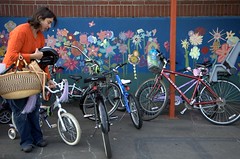The Safe Routes National Partnership has just released a new report detailing how five communities around the country — including Portland — have used Safe Routes to Schools programs to create safer walking and biking environments.
Titled Safe Routes to School: Putting Traffic Safety First (PDF), the report details how communities from Florida to California are participating in encouragement programs and making safety improvements that are affordable yet have “profound effects on keeping children safe while also improving physical health and the environment.”
The report puts statistics behind the Safe Routes rhetoric and will provide much-needed ammunition for advocates and planners looking to spur funding and policy changes that will get more kids walking and biking to school. The report also tries to show the urgency of the issue, citing statistics that show as family biking has increased in America, the percentage of children’s bicycle-related fatalities that take place in the street is also on the rise:
Currently, an estimated 88 percent of children’s bicycle-related fatalities take place in the street, an increase from 38 percent in 1990 and 47 percent in 2005.
As for Portland, the report features an encouraging stat that speaks to our city’s traffic safety efforts:
Over the past 22 years, Portland’s total traffic fatalities have declined six times faster than the trend in the rest of the country. At the same time, bicycle commuting has increased three-fold in 12 years.
As one of their case studies for Safe Routes success, the report focuses on Vestal Elementary School. Vestal is located on NE 82nd Ave (between Burnside and Glisan), which is one of the most dangerous streets in Portland. According to the report, ODOT analysis has revealed that 82nd has more crashes, injuries, and fatalities than any other street in the city and that it is home to five of the 24 most dangerous intersections in Portland.
Because of these stats, PBOT’s Safe Routes team has made Vestal one of their focus schools. The City has spent $97,000 on small traffic safety infrastructure projects. PBOT also partnered with the Portland Police Bureau to increase enforcement around the school (Vestal is one of just 100 school zones the PPB focuses on). According to the report, during the second week of September 2009, officers wrote 1,304 citations, issued 24 warnings, and arrested two people at 46 schools. About 90 percent of the citations issued were for speeding in a school zone.
PBOT’s Safe Routes efforts at Vestal seem to be working. Not only has the perception of safety among parents at the school improved, but the study also cites ODOT crash analysis from 1998 to 2007 that shows a steady decrease in total crashes and crash severity. “For example, total crashes decreased by nearly 25 percent and there was a 32 percent decline in pedestrian injuries from crashes.”
The Safe Routes National Partnership is gearing up to lobby Congress for funding in the new federal transportation bill. According to the group’s founding director Deb Hubsmith, they’ll ask for a tripling of funding for the program, from its current level of $183 million per year to $600 million per year.
Learn more about Safe Routes to School:



